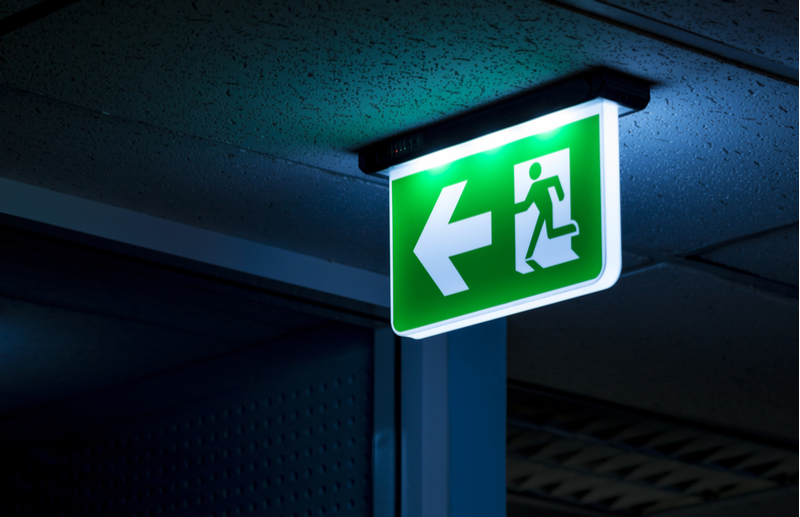Innovations in building escape technology
Organisations have a number of responsibilities to consider and implement in their everyday practices. These responsibilities not only protect the employees of a company, but also their external shareholders and members of the broader community. This includes customers and any other visitors to their business premises.

One of the most significant areas a business has to tackle is complying with workplace health and safety guidelines. A big part of this is suitably preventing and addressing fire risks.
In a report conducted by the Home Office, it highlighted that out of the 49,423 fire safety audits undertaken in 2017/18, only 68% were deemed satisfactory. Plus, of the 15,572 unsatisfactory audits, 14,734 resulted in informal notifications to resolve outstanding fire safety issues1. This statistic shows the extent of both non-compliance and confusion when it comes down to ensuring safe practices.
There have been several innovations to help businesses comply fully with safety regulations in recent years. Take a look below at some of the primary responsibilities for employers in the event of a fire, and how your business can make improvements to reduce risk.
Fire safety and responsibility in the workplace
In all cases, everyone needs to get out of a building safely and efficiently in the event of a fire. As an employer, it’s your responsibility to ensure there is a safe and clear way to exit the building. As detailed in the Regulatory Reform (Fire Safety) Order 2005, there are several aspects to consider including:
The travel distance to the nearest fire escape should be as short as possible (and not usually more than 18 metres)
Stairways, corridors and fire exits should be free from obstruction
Sufficient fire detection equipment should be in place to alert all staff and visitors
Fire exit doors should be easy to use without a key
It is ideal to have more than one fire exit
The escape should be a final exit to a safe place
There are several other aspects to think about, so be sure to check out this guide and the latest regulations for up to date advice.
Improvements in fire escapes and building escape technology
Over the past decade, changes in risk assessment and building regulations have helped improve fire safety and escape routes in commercial environments. Areas such as the width of fire exits are detailed in current building regulations and are dependent on the number of people in a building, the risk profile of occupants, and potential fire growth rate.
To accompany the escape route and final exit, other technology and innovation is helping to reduce fire risk in the workplace, including:
Fire and smoke detection system – this is the first alert to a fire risk and should be placed where all staff can hear the alarm.
Panic bars – this quick release system unlocks the fire exit in an emergency.
Emergency pads – this system is a release mechanism for doors secured with latches or bolts.
Glow-in-the-dark and illuminated fire exit signage – these signs show the way to the escape in the event of a power outage.
Fire-resistant paint – there is a selection of fire-retardant paint that helps to increase the fire resistance of wood, plaster and steel.
However, perhaps one of the most interesting innovations in building escape technology is emergency escape chutes. This system includes vertical fire resistant tubes that can be installed in multi-story buildings (often on the roof or through windows), giving people an effective alternative escape route to stairwells and fire doors when these are unable to be used. These tubes can either be static or portable to suit the needs and existing design of the building, and they’re already being offered throughout the UK.
Dynamic escape routing is another innovation that’s helping to improve and speed up how people exit buildings in the event of a fire. Dynamic escape routing systems are designed to help visitors of a building identify escape routes when they are blocked by smoke and fumes. A luminaire is installed in the floor of the building, guiding you towards the escape route when regular lighting systems are ineffective at doing so. This is supported by illuminated signs that have dynamic (changing) direction indicators to help you leave the premises as quickly as possible.
In 2017, researchers at the U.S. Forest Service and the University of Utah were also reported to be working on a new tool to make it easier for firefighters to determine safety zones and escape routes for buildings. Described as the “Google Maps for firefighters”, the tool utilises satellite maps to take into account terrain slopes, ground surface roughness and vegetation density to ensure the most effective journey to safety.
Another regulation introduced in 2015 highlights a specific wiring requirement in escape routes. This stipulates that wiring systems should have fire-resisting supports. Although firefighters are equipped with suitable flame resistant workwear, such as garments from the phs Besafe Flame Gear range, entanglement in wiring has caused several deaths and injuries in recent years. Implementing this change in electrical systems ensures the safety of firefighters and others in the event of a fire where there is wiring that hangs across escape routes2.
Undertaking risk assessments and applying preventative practices is the best way to keep your employees safe. Chat to us today about affordable safety solutions for your business.
Source
1.https://assets.publishing.service.gov.uk/government/uploads/system/uploads/attachment_data/file/749133/fire-prevention-protection-1718-hosb2118.pdf
2.https://electrical.theiet.org/wiring-matters/issues/54/fire-resisting-supports-in-escape-routes/